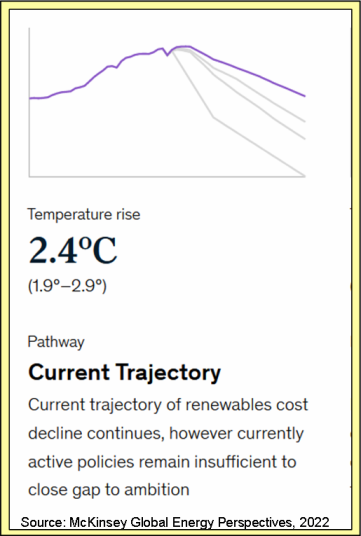“Limiting warming to 1.5°C and 2°C involves rapid, deep and in most cases immediate greenhouse gas emission reductions.” - Intergovernmental Panel on Climate Change (IPCC), 2023: Summary for Policymakers. In: Climate Change 2023: Synthesis Report.
Given that global emissions are still rising, we are not going to limit warming to 2°C by 2100. Per a recent McKinsey report, it’s looking more like 2.4°C:
So what does that mean for humans and the planet? Some predictions: unpredictable weather, extreme heatwaves, heat stressed cities, increased wildfires, severe droughts, water scarcity, increased frequency, intensity and/or amount of heavy rain and flooding, loss of species/mass extinctions, deforestation, lower crop yields, reduced food security, and widespread economic hardship. These problems will vary by region and local preparedness. Worst off will be countries that lack the resources or political will to build resilience and adapt to the coming onslaught of troubles.
What to do? To simplify: accelerate decarbonization, explore geoengineering build resilience, and adapt - without triggering a backlash. That would entail careful planning, flexibility, and a willingness to find common ground with political adversaries.
—
Related posts:
Climate Change Adaptations That are Good Ideas Even if You Don’t Believe in Climate Change
The Path to Manageable Climate Change without Destroying Civilization as We Know It
How Much will Sea levels Rise This Century and What Can Humans Do about It
How Can We Save Coral Reefs? A Primer
GM Crops, Climate Change and Protecting the Environment: The Latest Research
Is Techno-Optimism Reasonable? The Case of US Farmers and Climate Change
Reference: IPCC, 2023: Summary for Policymakers. In: Climate Change 2023: Synthesis Report. Contribution of Working Groups I, II and III to the Sixth Assessment Report of the Intergovernmental Panel on Climate Change [Core Writing Team, H. Lee and J. Romero (eds.)]. IPCC, Geneva, Switzerland, pp. 1-34, doi: 10.59327/IPCC/AR6-9789291691647.001
